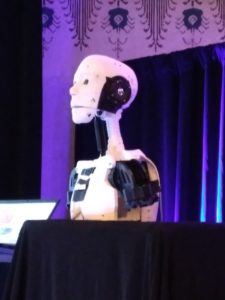We’re finishing up day 2 of bpmNEXT with a last section of demos.
Robotics, Customer Interactions and BPM, ITESOFT
 Francois Bonnet from ITESOFT presented on customer interactions and automation, and the use of BPMN-driven robots to guide customer experience. In a first for bpmNEXT, the demo included an actual physical human-shaped robot (which was 3D-printed from an open source project) that can do voice recognition, text to speech, video capture, movement tracking and facial recognition. The robot’s actions were driven by a BPMN process model, with activities such as searching for humans, recognizing faces, speaking phrases, processing input and making branching decisions. The process model was shown simultaneously, with the execution path updated in real time as it moved through the process, with robot actions shown as service activities. The scenario was the robot interacting with a customer in a mobile phone shop, recognizing the customer or training a new facial recognition, asking what service is required, then stepping through acquiring a new phone and plan. He walked through how the BPMN model was used, with both synchronous and asynchronous services for controlling the robot and invoking functions such as classifier training, and human activities for interacting with the customer. Interesting use of BPMN as a driver for real robot actions, showing integration of recognition, RPA, AI, image capture and business services such as customer enrolment and customer ID validation.
Francois Bonnet from ITESOFT presented on customer interactions and automation, and the use of BPMN-driven robots to guide customer experience. In a first for bpmNEXT, the demo included an actual physical human-shaped robot (which was 3D-printed from an open source project) that can do voice recognition, text to speech, video capture, movement tracking and facial recognition. The robot’s actions were driven by a BPMN process model, with activities such as searching for humans, recognizing faces, speaking phrases, processing input and making branching decisions. The process model was shown simultaneously, with the execution path updated in real time as it moved through the process, with robot actions shown as service activities. The scenario was the robot interacting with a customer in a mobile phone shop, recognizing the customer or training a new facial recognition, asking what service is required, then stepping through acquiring a new phone and plan. He walked through how the BPMN model was used, with both synchronous and asynchronous services for controlling the robot and invoking functions such as classifier training, and human activities for interacting with the customer. Interesting use of BPMN as a driver for real robot actions, showing integration of recognition, RPA, AI, image capture and business services such as customer enrolment and customer ID validation.
The Future of Voice in Business Process Automation, K2
Brandon Brown from K2 looked at a more focused use case for voice recognition, and some approaches to voice-first design that is more than just speech-to-text by adding cognitive services through commodity AI services from Google, Amazon and Microsoft. Their goal is to make AI more accessible through low/no-code application builders like K2, creating voice recognition applications such as chatbots. He demonstrated a chatbot on a mobile phone that was able to not just recognize the words that he spoke, but recognize the intent of the interaction and request additional data: essentially a replacement for filling out a form. This might be a complete interaction, or just an assist for starting a more involved process based on the original voice input. He switched over to a computer browser interface to show more of the capabilities, including sentiment analysis based on form input that could adjust the priority of a task or impact process execution. From within their designer environment, cognitive text analytics such as sentiment analysis can be invoked as a step in a process using their Smart Objects, which are effectively wrappers around one or more services and data mapping actions that allow less-technical process designers include cognitive services in their process applications. Good demo of integrating voice-related cognitive services into processes, showing how third-party services make this much more accessible to any level of developer skill.
State Machine Applied to Corporate Loans Process, BeeckerCo
Fernando Leibowich Beker from BeeckerCo finished up the day with a presentation on their process app suite BeBOP based on IBM BPM/ODM focused on financial services customers, followed by a “demo” of mostly prerecorded screencams. Their app generates state tables for processes using ODM business rules, then allows business users to change the state table in order to drive the process execution. The demo showed a typical IBM BPM application for processing a loan origination, but the steps are defined as ad hoc tasks so not part of a process flow; instead, the process flow is driven by the state table to determine which task to execute in which order, and the only real flow is to check the state table, then either invoke the next task or complete the process. Table-driven processes aren’t a new concept — we’ve been doing this since the early days of workflow — although using an ODM decision table to manage the state transition table is an interesting twist. This does put me in mind of the joke I used to tell when I first started giving process-focused presentations at the Business Rules Forum, about how a process person would model an entire decision tree in BPMN, while a rules person would have a single BPMN node that called a decision tree to execute all of the process logic: just because you can do something using a certain method doesn’t mean that you should do it.
We’re done with day 2; tomorrow is only a half-day of sessions with the awards after lunch (which I’ll probably have to monitor remotely since I’ll be headed for the airport by mid-afternoon).
